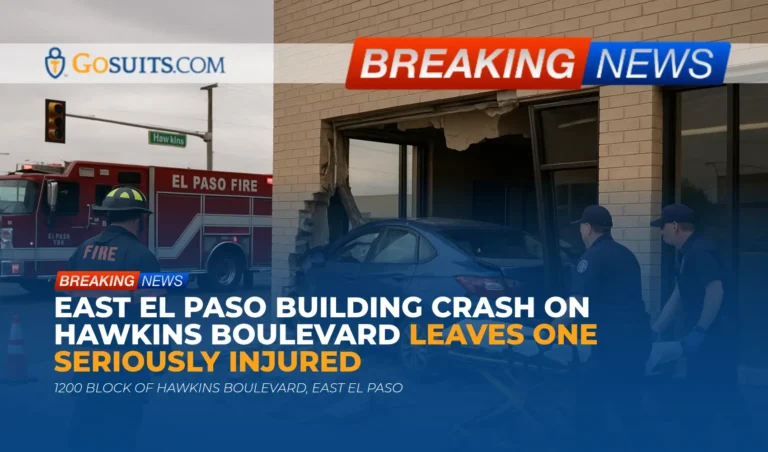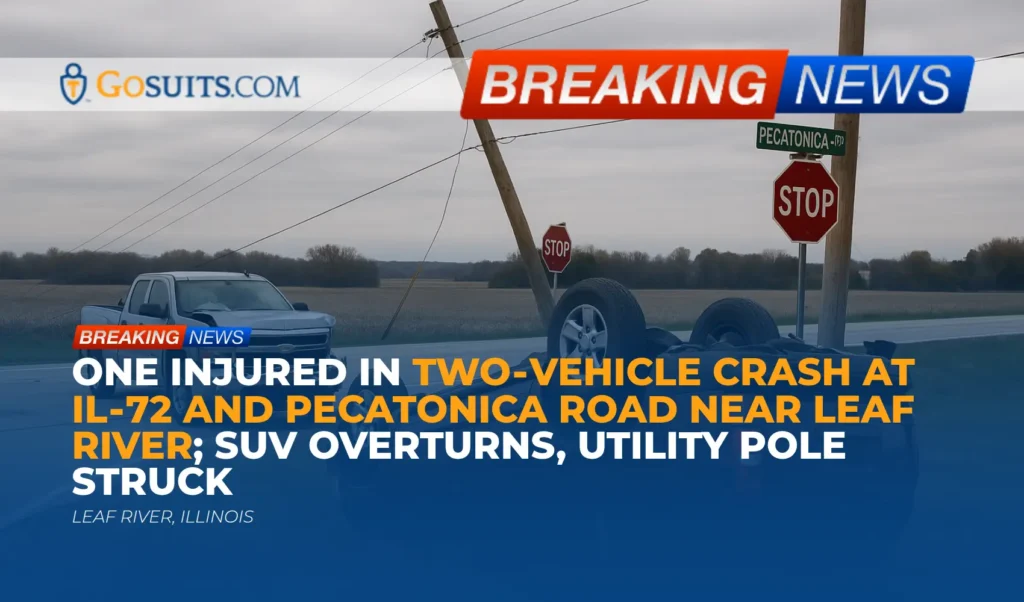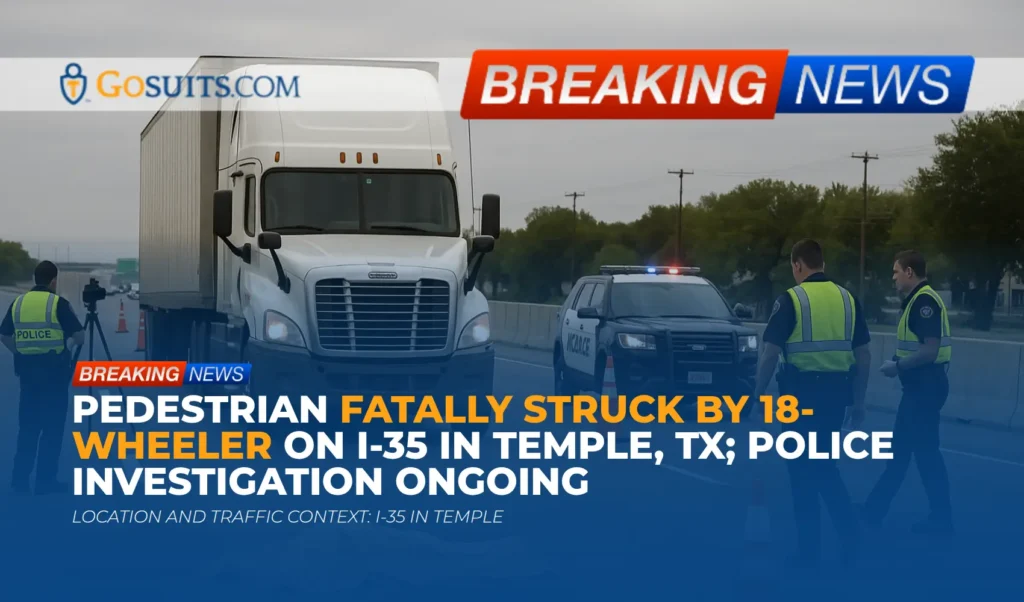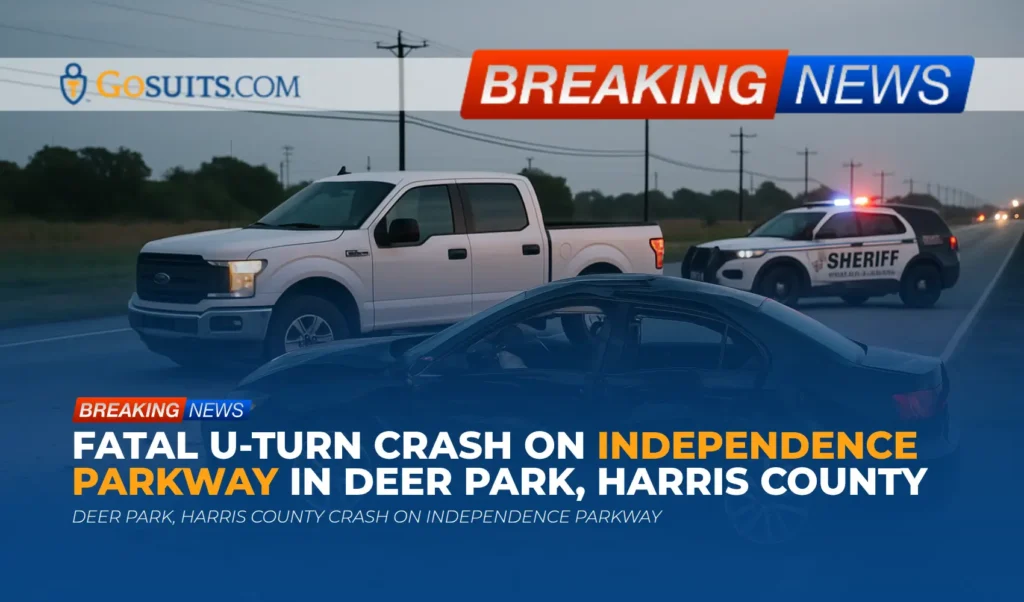- What We Know So Far About the East El Paso Building Crash
- Location, Timing, and Emergency Response
- Safety Context: Intersections, Stop Signs, and Crash Severity
- What Investigators Typically Look For After a Vehicle-Into-Building Collision
- Potential Civil Liability Paths in Texas
- Insurance Considerations and Common Pitfalls
- Preserving Evidence and Documenting Losses
- How to Obtain Official Records and Reports
- Support Services and Helpful Contacts in the El Paso Area
- Common Injuries in High-Energy Impact Crashes Into Buildings
- Understanding Timelines: Notices and Filing Deadlines in Texas
- Take Action: Steps People Commonly Consider After Serious Crashes
- Commentary from Gosuits El Paso, Texas Personal Injury Attorney
- Key Laws and Government Resources Cited
What We Know So Far About the East El Paso Building Crash
Local reports indicate that one person sustained serious injuries when a vehicle crashed into a building in East El Paso on Monday afternoon. According to the El Paso Fire Department, emergency crews were dispatched around 3:19 p.m. to the 1200 block of Hawkins Boulevard. Early reports noted that an air ambulance was initially considered, but the patient was ultimately transported to a hospital by ground ambulance. The injured person was described as “code 3,” a term commonly used by emergency responders to denote serious injuries. Additional details about the cause of the crash or the injured person’s condition have not been released.
Dashcam video circulating on social media reportedly shows a blue car traveling through a stop sign, striking the median on Hawkins Boulevard, becoming airborne, and crashing. As of this writing, the incident remains under investigation and information is developing. Details such as contributing factors, the identity of those involved, and the extent of damage inside the building have not been confirmed publicly. This overview is based only on information made public at this time.
Location, Timing, and Emergency Response
The incident location, the 1200 block of Hawkins Boulevard in East El Paso, is a busy corridor with multiple intersecting streets, commercial properties, and regular local traffic. Intersections in such areas can present visibility challenges, varying traffic speeds, and complex turn movements. The time of day, mid-afternoon, typically correlates with steady traffic volumes that may include school pickups, deliveries, and workday travel.
Emergency response was led by the El Paso Fire Department and allied agencies. The decision to transport by ground ambulance rather than helicopter is often made by medics on-scene based on current patient stability, transport time, and the availability of trauma centers nearby. The “code 3” designation indicates serious injury, but more precise medical details are not public at this time.
Safety Context: Intersections, Stop Signs, and Crash Severity
Intersections are common sites of roadway conflicts, especially when drivers fail to come to a complete stop, disregard right-of-way, or are traveling too fast for conditions. Federal highway safety research emphasizes that intersection-related crashes are a significant portion of traffic incidents nationwide, and intersection safety remains a priority area for engineers and communities. The Federal Highway Administration maintains resources on intersection safety strategies that can reduce severity and frequency of these crashes, including signage, visibility improvements, and traffic calming measures. See FHWA Intersection Safety.
The dynamics described publicly in this event, including failure to stop and a high-energy impact, are consistent with serious injury risk. NHTSA highlights that higher speeds increase stopping distance and crash energy, which can magnify the severity of injuries and property damage. For more on the role of speed in crash outcomes, see NHTSA on Speeding and Crash Severity.
Texas law requires drivers to obey stop signs and yield the right-of-way where appropriate. Under the Texas Transportation Code, drivers must stop at stop signs and yield to vehicles that constitute an immediate hazard when proceeding. These rules are designed to prevent high-risk conflicts at intersections. Relevant statutes include Texas Transportation Code § 544.010 and § 545.151.
What Investigators Typically Look For After a Vehicle-Into-Building Collision
Although official findings for this incident are pending, post-crash investigations commonly focus on the following areas:
- Traffic control compliance including stop sign adherence, proper yielding, and line-of-sight at the intersection. Investigators may review the physical positioning of signs and any obstructed views.
- Speed and vehicle control determined through roadway evidence such as skid marks, vehicle data recorders when available, and witness or video accounts that suggest loss of control or high speed.
- Driver impairment or distraction assessed through on-scene observations, statements, and potentially toxicology if warranted. This pertains to civil liability if unlawful or negligent conduct is established.
- Mechanical failure such as brake or steering issues, evaluated through vehicle inspection when necessary.
- Roadway and environmental factors including weather, lighting, and surface conditions that could have contributed to the crash.
- Building damage and occupant safety including structural impacts, utilities, and any injuries to people inside the structure at the time of the collision.
Investigators typically compile these findings into an official crash report. In Texas, peace officers submit standardized crash reports that can later be obtained by eligible parties through the Texas Department of Transportation. See TxDOT Crash Reports.
Potential Civil Liability Paths in Texas
Every collision is fact-specific, and responsibility is determined by the evidence. Generally, potential civil liability paths in a vehicle-into-building crash may include:
- Negligent driving by the at-fault motorist. If a driver ran a stop sign or failed to yield, that conduct can support civil liability for injuries and property damage. Texas statutes require compliance with traffic control devices and safe intersection entry. See § 544.010 and § 545.151.
- Comparative responsibility. Texas follows a modified comparative fault system in many negligence cases, which can reduce recoverable damages if multiple parties share responsibility. The exact apportionment depends on the facts documented in the case. Statutory allocation of responsibility is addressed in the Texas Civil Practice and Remedies Code.
- Employer liability (if on the job). If the driver was operating a vehicle in the course of employment, the employer’s insurer may be implicated under respondeat superior principles, depending on the facts.
- Third-party factors. In select cases, vehicle defects or negligent maintenance might be relevant. These require technical investigation and documentation.
- Property owner damages. Building owners and tenants typically pursue claims for structural repairs, business interruption, and contents damage against the at-fault driver’s insurance. Safety code issues may be evaluated, but responsibility for the crash itself often centers on the driver’s conduct.
Wrongful death claims require distinct proof of negligence and causation. When a collision results in a fatality, immediate family may have claims under Texas law, subject to the same evidentiary and insurance considerations described here.
Insurance Considerations and Common Pitfalls
Insurance coverage and processes vary by policy and by the facts of the collision. Common coverages that may come into play include:
- Liability coverage of the at-fault driver for bodily injury and property damage. This is often the primary source for medical damages, lost income, and building repairs.
- Uninsured or underinsured motorist coverage on the injured person’s policy can apply if the at-fault driver is uninsured or if damages exceed the liability limits. This coverage can also apply to pedestrians or occupants of a building in some circumstances, depending on policy language.
- Medical payments or personal injury protection coverages that may assist with immediate medical costs regardless of fault, subject to policy terms.
- Commercial policies if the driver was operating a company vehicle or driving within the scope of employment.
- Property and business insurance for building owners and tenants, including loss of use or business interruption where available.
It is common for insurance adjusters to reach out early, request recorded statements, or ask for broad medical authorizations. People sometimes do not realize that statements made to insurers can be used to dispute liability or minimize damages later. For that reason, it is prudent to speak with a qualified attorney before providing recorded statements or signing authorizations. A consultation can help clarify rights, obligations, and the best sequence of steps. This article is general information only.
Preserving Evidence and Documenting Losses
Evidence can disappear quickly, which affects both liability and damages. In serious crashes, it is helpful to consider the following:
- Secure video footage from dashcams, nearby businesses, or residences. Video can establish approach speed, signaling, lane position, and the precise moment of impact.
- Photograph the scene including vehicle positions, debris fields, skid or yaw marks, the location of stop signs, and damage to the building exterior and interior.
- Obtain names and contact information for witnesses. Independent witness accounts often help resolve disputes about traffic control compliance and right-of-way.
- Preserve the involved vehicle if feasible. Mechanical inspections and data downloads from onboard systems can be essential in contested cases.
- Keep medical documentation such as imaging, discharge summaries, and specialist referrals. Track out-of-pocket expenses, mileage to medical appointments, and time away from work.
- Record property losses including structural repair estimates, invoices, and any business interruption impacts.
When a governmental entity may hold relevant evidence, Texas open records laws can help the public request documents. Guidance on making a Public Information Act request is available through the Office of the Attorney General at How to Request Public Information.
How to Obtain Official Records and Reports
Official records clarify facts, establish timelines, and document injuries and damages. The following pathways are commonly used after serious crashes in Texas.
Crash Report (Police CR-3)
Most reportable crashes investigated by law enforcement result in a Texas Peace Officer’s Crash Report, also called the CR-3. Eligible parties can obtain the official crash report through the Texas Department of Transportation’s Crash Records system. See TxDOT Crash Reports. The report typically includes:
- Date, time, and location of the crash
- Vehicles and persons involved and their roles
- Apparent contributing factors such as failure to stop, speed, or distraction
- Diagram and narrative compiled by the investigating officer
In some cases, supplemental diagrams, photos, or witness statements may be available from the investigating agency through a public information request to the City of El Paso, subject to legal exemptions.

City Fire Department Incident Report
The El Paso Fire Department may create incident or patient care documentation. Requests for incident records can typically be made through the City’s public information process. Information that involves medical details is often limited by privacy laws, but basic incident data may be available. The City’s process for public information requests is governed by the Texas Public Information Act. General guidance on requesting public records is provided by the Texas Attorney General at this link.
911 Audio and Computer-Aided Dispatch Logs
911 call audio and dispatch logs can establish response times, initial observations, and sequence of events. In Texas, these records may be requested through the applicable city or county, subject to statutory exemptions for sensitive information. Again, the Texas Public Information Act governs access and timing for governmental records requests. See the Texas AG’s open government portal: Open Government.
Medical Examiner or Autopsy Records
If a crash results in a fatality, Texas law provides for medical examiner jurisdiction in certain counties and justice of the peace inquests in others. Autopsy reports may be released with redactions, subject to statutory restrictions. The Texas Code of Criminal Procedure provides general provisions for medical examiners. See Code of Criminal Procedure art. 49.25. Each county’s medical examiner or inquest authority handles requests; procedures vary by county.
Property Damage and Building Safety Records
For a vehicle-into-building crash, code enforcement or building safety teams may document structural impacts. Copies of notices, inspection results, or utility shutoff orders can sometimes be requested from the city’s code compliance or building safety division. Availability and timing are subject to the Texas Public Information Act and any emergency response confidentiality provisions.
Support Services and Helpful Contacts in the El Paso Area
Below are general categories of agencies and services that people often contact following a serious crash. Specific phone numbers and procedures can change, so checking the official City of El Paso or County websites is recommended before calling or submitting requests.
- El Paso Police Department: For crash case numbers and information about requesting supplemental materials, visit the City of El Paso’s official website. Public records are requested under the Texas Public Information Act through the City’s open records portal.
- El Paso Fire Department: For incident records related to emergency response, the City’s public information request process applies and may provide incident summaries or non-medical details.
- Texas Department of Transportation (TxDOT): The official channel to purchase the Texas Peace Officer’s Crash Report (CR-3) is the TxDOT Crash Records system. See TxDOT Crash Reports.
- El Paso County medical examiner or inquest authority: For autopsy or inquest records when applicable, requests are directed to the county’s designated office, subject to the Code of Criminal Procedure and privacy laws.
- City Building Safety or Code Enforcement: For structural inspection records or orders related to a building strike, the City may have responsive documents accessible via an open records request.
- Victim and survivor support resources: Local hospitals often have social workers and care coordinators. Community assistance programs may offer short-term support with transportation, counseling referrals, or lodging in complex cases. Availability varies by agency.
Common Injuries in High-Energy Impact Crashes Into Buildings
Vehicle-into-building crashes can involve high-energy impacts that injure vehicle occupants and sometimes people inside the structure. Common injuries include:
- Head and brain injuries from direct impact or rapid deceleration. Symptoms can be immediate or delayed.
- Spinal trauma including herniated discs or vertebral fractures, sometimes presenting with radiating pain or numbness.
- Chest and abdominal injuries such as rib fractures, internal organ trauma, or seatbelt-related injuries.
- Orthopedic injuries including fractures to extremities, pelvis, or shoulders due to blunt force or collapse of structural elements.
- Soft tissue injuries including sprains, tears, and contusions that may require therapy and ongoing care.
- Psychological trauma including anxiety and post-incident stress. Counseling and follow-up care are important in the recovery process.
Medical evaluation should follow clinical guidance. Documentation of diagnosis, treatment plans, and follow-up needs is central to any insurance claim or civil case involving personal injury.
Understanding Timelines: Notices and Filing Deadlines in Texas
Civil claims are governed by deadlines that can bar recovery if missed. In Texas, many personal injury and wrongful death claims have a two-year limitations period, though exceptions can apply depending on the parties and facts. See Texas Civil Practice and Remedies Code § 16.003. Additional, shorter timelines may apply when governmental entities are involved, including notice requirements. Because deadlines are fact-dependent, it is sensible to consult an attorney early to understand applicable timelines. This article provides general, educational information.
Take Action: Steps People Commonly Consider After Serious Crashes
The period after a serious crash is often confusing and overwhelming. The checklist below explains practical next steps many people consider to protect their health, document losses, and avoid common claim pitfalls. This guidance is educational and not case-specific.
- Prioritize medical care. Timely evaluation can uncover injuries that are not obvious at the scene. Following medical advice creates a clear record of causation and treatment needs.
- Contact an attorney before speaking with insurers. Initial calls with insurance adjusters are often recorded, and statements can be used later to dispute liability or damages. A free consultation can help a person understand rights and plan the safest sequence of steps.
- Request official records. Obtain the police CR-3 report through TxDOT, consider requesting fire incident summaries, and preserve 911 or dispatch data where available. Government records often anchor the timeline and facts. See TxDOT Crash Reports and Public Information Act guidance.
- Preserve video and scene evidence immediately. Nearby businesses may overwrite surveillance footage within days. Quick outreach can prevent the loss of critical evidence.
- Document all expenses and impacts. Save medical bills, receipts, repair estimates, and records of missed work or business interruption. Consistent documentation supports economic loss claims.
- Caution with social media. Public posts can be misconstrued or used out of context by insurance carriers. Limiting public commentary about the incident reduces risk.
- Assess all insurance coverages. In addition to the at-fault driver’s liability policy, review any applicable uninsured or underinsured motorist coverage, medical payments, PIP, and property policies.
- Consider engineering or reconstruction analysis. In higher-stakes cases, professional reconstruction, vehicle downloads, or structural assessments may be warranted to establish speed, trajectory, or impact forces.
Why acting promptly matters:
- Evidence can vanish quickly. Video systems overwrite, vehicles are repaired or salvaged, and witnesses become harder to locate as time passes.
- Deadlines apply. Statutes of limitation and notice requirements can bar claims if missed. Early review helps identify and calendar all thresholds.
- Medical outcomes improve with early care. Prompt diagnosis and therapy often reduce long-term complications and clarify the medical record for any claim.
- Insurers often move fast. Early offers can undervalue long-term needs. Understanding the full scope of damages typically takes time and careful review.

Commentary from Gosuits El Paso, Texas Personal Injury Attorney
Our thoughts are with everyone affected by the building crash reported on the 1200 block of Hawkins Boulevard. Incidents like this are frightening and can change lives in an instant. This commentary is for educational purposes and general information, intended to help community members understand the civil process that often follows a serious vehicle collision.
Based on the public details so far, investigators will likely focus on stop sign compliance, approach speed, and control of the vehicle. They may also look for corroborating video, witness accounts, and mechanical or environmental factors. If the dashcam video accurately depicts a failure to stop and a high-energy impact, that points toward a significant breach of the duty to operate a vehicle with reasonable care. However, final conclusions should come from the official investigation and the complete factual record.
From our perspective handling serious crash cases, insurance companies and large corporations frequently leverage the early confusion that follows a traumatic event. Adjusters may request recorded statements before injuries are fully understood, ask for broad medical authorizations, or push for quick settlements that do not account for future treatment, lost earning capacity, or the full extent of property and business losses. People sometimes do not realize that what they say in those early conversations can be used to minimize or dispute their claims later.
A free consultation with a seasoned personal injury attorney can provide clarity about rights, insurance coverage options, and the safest order of steps. It can also help identify critical evidence to preserve immediately, such as video or vehicle data, and illuminate deadlines that may apply. With the right information at the outset, families and property owners are in a better position to make informed decisions as the investigation unfolds.
Key Laws and Government Resources Cited
- Federal Highway Administration, Intersection Safety
- NHTSA, Speeding and Crash Severity
- Texas Transportation Code § 544.010, Stop Signs
- Texas Transportation Code § 545.151, Vehicle Entering Intersection
- TxDOT, Texas Peace Officer’s Crash Reports (CR-3)
- Texas Attorney General, How to Request Public Information
- Texas Code of Criminal Procedure art. 49.25, Medical Examiners
- Texas Civil Practice and Remedies Code § 16.003, Limitations






